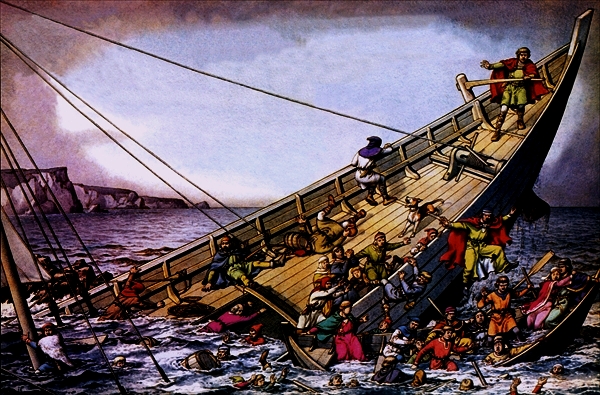
Thursday November 25th 1120 AD
King Henry sailed safely from Barfleur on Thursday night, but his son Prince William, along with many members of his family, eminent noblemen, councillors and companions as well as distinguished clerics, advisers and courtiers perished in a tragic accident when their late-night ferry struck off-shore rocks at Barfleur.
The notorious harbour at Barfleur, about one and a half miles south of the Pointe de Barfleur, is known by mariners and pilots as one of the most difficult to navigate. It is tidal with a stream or race (raz) reaching five knots at spring tides, making conditions difficult for ships entering and leaving the harbour. Crossings often occur at night when navigators can use the Pole Star and normally take between ten and twelve hours. On November 25th high water was at 10.43 pm and conditions were calm, though dark with a new moon. Ships would not be afloat until 8pm and could not sail until the race slackened after 10pm.
Princes William and Richard on board doomed ship
The day before the catastrophe, while the king was at Barfleur to take ship for England after a successful round of negotiations with Flanders, Anjou, Ponthieu and the king of France, master-mariner Thomas FitzStephen came to the king with a particular request. Offering a mark of gold (6 pounds), he asked for his father’s former position as royal steersman. His father, Stephen, had carried William to England in 1066 and served him loyally for the rest of his life. Thomas had a fine vessel, 35 metres in length and up to four metres in the beam, called The White Ship, recently refitted to top specifications, with capacity for fifty oarsmen and the latest side-rudder design. King Henry declined to board the ship, having already booked his cross channel passage on another vessel, but agreed to commit his sons, William and Richard, and many of their young circle to The White Ship.
Rumours of drinking on board
About three hundred people crammed aboard the ship. Some later disembarked because they suspected that the young men, rowdy with drink, were getting out of hand. There were about fifty experienced oarsmen and marine guards, some of whom had been drinking heavily. A drunken scene occurred as priests from the Abbey of Coutances were jeered and chased away when they tried to bless the vessel. The King’s ship set out and cleared the dangerous rocks following the safest channel to the north-east which avoids all the hazards of hidden rocks. It was then about 11.30pm. As the White Ship cleared the harbour, some of the Prince’s entourage urged the captain to try to overtake the King’s ship but, under the spurt of fifty drink-fuelled rowers, the ship veered to the north-west and ended up hitting the dangerous Quilleboeuf Rock one nautical mile from Barfleur and half a mile from the shore. Two planks in the starboard bow were shattered but it was only when sailors tried to push the ship off the rock that it suddenly capsized.
Terrified screams of dying heard on shore
A life boat was launched which took Prince William safely on board with some of his close companions but he gave orders to turn back to save his sister, the countess of Perche, a decision which proved fatal. As his boat returned to the wrecked ship it was swamped by the number of people who jumped down into it, overwhelming the little boat and throwing seventeen-year-old Prince William and his companions into the sea where they drowned. Hearing that the King’s son had perished, Thomas, who had been clinging to a spar in the water, cast himself adrift to die. The cries of the drowning people were audible along the shore and heard by the priests who had tried to bless the voyage, including the Bishop of Coutances whose son, brother and three nephews, were aboard. The King, meanwhile, sailing safely to England, had no idea of the disaster occurring in his wake and no-one dared to bring him news until late on Friday when he is said to have fallen to the ground, overcome by grief.
Death toll rises through the night
The immensity of the loss, both personal and political, is on a scale of magnitude that almost defies comprehension. The casualties include not only the king’s two sons and daughter Matilda, but his nieces, along with Matilda of Blois, her husband Richard, Earl of Chester, and Richard’s half brother, Othuer FitzCount, tutor of Prince William, two sons of Ivo de Grandmesnil, William of Rhuddlan and members of the royal household, William Bigod, Geoffrey Ridel, Hugh de Moulins, Robert Mauduit and Gisulf the scribe. Eighteen noblewomen died, the daughters, sisters and wives of some of the most eminent of the king’s trusted companions in arms and loyal servants. Their bodies, carried away by the strong tide, have not been recovered though local divers are being paid to undertake a search. Late the following day, the wreck of the ship was brought ashore, still containing all its cargo and the king’s treasure. No consolation to a king who has lost to the rocks and tides of Barfleur the irreplaceable treasure of a legitimate heir, whose loss threatens to plunge the country into a succession crisis. Stephen of Mortain, who left the ship before it sailed, suffering from a severe bout of diarrhoea, was too distressed to make any comment. At present, the whereabouts of the sole survivor, Beroud of Rouen, rescued by fishermen the following morning suffering from shock and hypothermia, is unknown.
